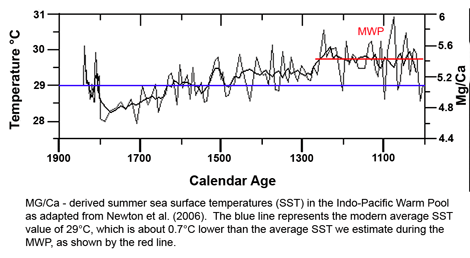Reference
Newton, A., Thunell, R. and Stott, L. 2006. Climate and hydrographic variability in the Indo-Pacific Warm Pool during the last millennium. Geophysical Research Letters 33: 10.1029/2006GL027234.
Description
Working with a sediment core collected at 5°12.07'S, 117°29.20'E in the Indo-Pacific Warm Pool (one of the warmest regions in the modern oceans), Newton et al. analyzed planktonic foraminiferal (Globigerinoides ruber) Mg/Ca and δ18O data to derive high-resolution summer sea surface temperature (SST) and salinity histories extending back in time about a thousand years. This work revealed, in their words, that "the warmest temperatures and highest salinities occurred during the Medieval Warm Period," which lasted from about AD 1020 to 1260. Over this period, summer SSTs averaged about 29.7°C, as best we can determine from their graph of the data, with a peak of about 30.9°C in the vicinity of AD 1080, which values are to be compared with "the average modern summer SST [of] 29°C." Consequently, modern summer temperatures still average about 0.7°C less than those of the Medieval Warm Period.





